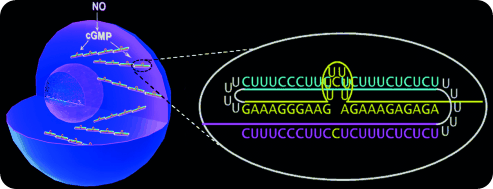Jul 10 2014
The transmission of signals within cells is dependent on cyclic guanosine monophosphate (cGMP) as an important secondary messenger. German scientists have now developed an RNA that binds cGMP. As reported in the journal Angewandte Chemie, it is possible to suppress the cGMP signal cascade in genetically modified cells that produce this RNA.
cGMP plays an important role in processes such as the relaxation of the smooth muscle tissue in blood vessels and consequently in the regulation of blood pressure. Malfunction of the cGMP signaling pathway may be related to cardiovascular disease. Experimental manipulation of the endogenous cGMP levels in cells should lead to a better understanding of the spatial and temporal dynamics involved, as well as the functionality of cGMP. While there are many ways to stimulate cGMP, including the use of nitrogen monoxide (NO), researchers have thus far not had a means to artificially lower cellular cGMP concentration.

Scientists from the Universities of Stuttgart and Tübingen have now developed a method by which they can “trap” cGMP molecules in cells. To achieve this they genetically modified the cells to produce specially designed RNA molecules that bind cGMP.
RNA, ribonucleic acid, is familiar to us as a building block of ribosomes, an amino acid transporter, and as messenger RNA, which copies blueprints from DNA and transports them to the ribosomes, where protein synthesis takes place. Further physiological roles have also now been found, such as catalytically active RNAs or RNAs that regulate gene expression by binding to complementary sequences. In addition, there are riboswitches, sequences in the messenger RNA that bind low-molecular metabolites and thus regulate gene expression.
A team led by Stuttgart chemist Clemens Richert and Tübingen biochemist Robert Feil has now successfully used specially developed RNA sequences to reduce the concentration of small molecules capable of base pairing in cells. To achieve this, the Stuttgart chemists developed a special folding motif that binds cGMP. The structure is based on a triple strand of RNA, known as a triplex. One of the three strands forms a loop that frames the binding cavity for cGMP. This motif is repeated multiple times in a long continuous sequence, so the researchers named their RNA construct “endless”.
In order to test the functionality of the “endless” construct in living cells, the biochemists in Tuebingen produced an artificial gene that codes for the “endless” RNA, and introduced it into cells obtained from the blood vessels of mice. This is a well-established model for the study of cGMP signaling pathways. In these cells, NO triggers signal cascades transmitted by cGMP. In cells that expressed “endless”, these cascades were suppressed and the cGMP level was significantly lower than in control cells. The “endless” RNA acts as a sink for cGMP and should be very useful in further research into the physiological role of cGMP.
Source: Angewandte Chemie International Edition